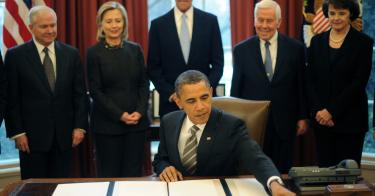Analysts at the Brookings Institution have called extending the New Strategic Arms Reduction Treaty (New START) a “no brainer.” In reality, the United States is better off letting New START expire.
The arms control treaty with Russia was negotiated in 2010 — five years before Moscow dismembered Ukraine — by an administration that assumed Russia was no longer an adversary.
That assumption led to a treaty hopelessly lopsided in Russia’s favor. Consider this: It did not require Russia to eliminate a single warhead. Instead, it allowed Russia to increase its countable nuclear warheads, even as it made the United States continue to draw down.
Proponents of New START argue that the treaty’s verification provisions provide an important element of transparency between two countries. There is a grain of truth to that — the provisions increase transparency, but they have little to do with verification. In fact, they make it hard to detect Russia’s potential noncompliance.
For example, New START does not provide a basis to learn how many warheads Russia deploys on each of its intercontinental ballistic missiles (ICBMs). The Obama administration negotiated away telemetry provisions that would allow us to get an insight into this important characteristic.
Moreover, warheads in maintenance facilities and systems away from a base are off-limits to inspectors, further diminishing our understanding of the composition of Russia’s nuclear forces. Inexplicably, the treaty also allows concealment activities on ICBM bases.
These lackluster verification provisions mean that even if Russia cheated on New START, it would be almost impossible for the United States to find out about it and then charge Russia with violating the treaty. And Moscow has a long record of disregarding treaty obligations.
Indeed, Russia has cheated on almost every arms control agreement it has ever signed. Its blatant deployments of intermediate-range ballistic missiles led to the demise of the Intermediate-Range Nuclear Forces Treaty. Russia killed a British citizen and poisoned three others by using a chemical weapon, despite having ratified the Chemical Weapons Convention.
The notion that Moscow was no longer a national security headache was naive in 2010. After all, Russiahad invaded Georgia in 2008 and had never ceased making nuclear threats against U.S. allies.
Today, that notion is even more far-fetched, what with Russia’s occupation of Crimea, its ongoing military aggression in Ukraine and its destabilizing adventurism in Syria.
Forget about a Russian “reset.” The era of a great power competition is back, and Russia is serious about winning. Its nuclear forces are about 80 % modernized now and will be pretty close to 100 % modernized by next year, according to Gen. John Hyten, commander of U.S. Strategic Command.
Moreover, Russia is building new nuclear weapons outside of the New START: a new ICBM capable of carrying multiple nuclear warheads, a nuclear cruise missile, and an autonomous nuclear-armed underwater torpedo. The relevance of New START decreases every day.
Perhaps New START’s greatest flaw, however, is that it left Russia’s tactical nuclear weapons unscathed. It’s a huge problem, because Russia has at least a 10:1 advantage in this class of weapons. To make matters worse, Russia seems keen on adopting and exercising strategies that envision using tactical nuclear weapons first in conventional conflict — as a way to communicate resolve and make the United States back down.
To address Russia’s misconceptions and to strengthen U.S. ability to compete in a new era, the United States must continue its own nuclear weapons modernization program started under the Obama administration. The Trump administration made modest changes to the program of record in response to aforementioned development in Russia’s nuclear doctrine, including adding a low-yield warhead for a submarine-launched ballistic missiles.
U.S. and allied security depends on a successful execution of this program, regardless of whether New START is extended. But as it stands today, renewing New START would not be in the best security interests of the United States.
This piece originally appeared in The Washington Times



